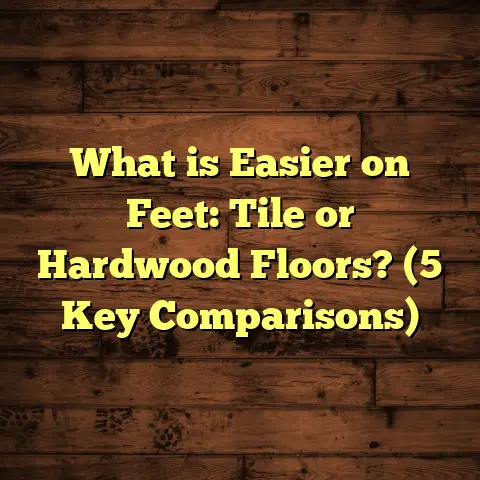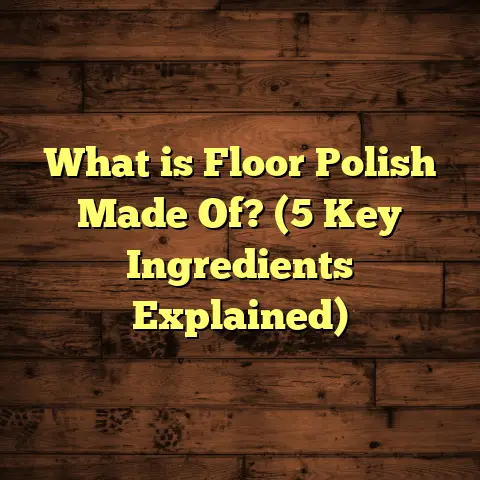What is Moulding that Runs Along the Floor? (5 Key Styles Explained)
I want to share something that’s saved me a ton of headaches and added a neat finishing touch to my home’s look — moulding that runs along the floor. If you’ve ever walked into a room and admired how polished and complete it felt, chances are the floor moulding caught your eye, even if you didn’t realize it at the time. It’s more than decoration; it’s a smart way to protect your walls and floors while giving your space a finished vibe.
What Is Moulding That Runs Along the Floor?
So, what exactly is this moulding? Simply put, it’s a narrow strip of wood, MDF, or other materials that sits at the base of your walls where they meet the floor. Sometimes called baseboard, skirting board, or floor moulding, it serves several practical and aesthetic roles. It hides the gap between the wall and floor, covers any uneven edges or cuts in flooring, protects the lower portion of walls from scuffs and bumps, and adds a final decorative flourish to a room.
I’ve installed and worked with many kinds of floor mouldings over the years. I can tell you this: choosing the right style makes a big difference in how your space feels. But it’s not just about looks — the right moulding can save you money by protecting your walls and making cleaning easier.
Why Does Floor Moulding Matter So Much?
You might wonder why moulding is even necessary if it’s just a thin strip along the wall. Well, think about this: floors expand and contract with humidity changes, especially hardwood. Without something covering that gap, you’d see unsightly cracks or gaps that collect dirt. Plus, moving furniture or vacuuming can chip your walls if there’s no protective barrier.
On top of that, moulding helps hide wiring or cables running along floors in some homes. When I helped a friend remodel her living room, we used a tall baseboard with a groove to tuck wires away — saved her from a messy look without drilling into walls.
How Big of an Impact Can Floor Moulding Have?
If you don’t already have moulding or have minimal baseboards, you might not realize how much difference it makes until it’s installed. In one house I worked on, installing 4-inch colonial baseboards turned a bland room into something warm and inviting. The baseboards created visual boundaries that made the floors feel more grounded and the walls more substantial.
The other side? I’ve seen rooms where poor moulding choices made spaces feel unfinished or cheap. For example, a thin 1-inch flat moulding in a large room with high ceilings looked dwarfed and didn’t protect walls from scuffs, leading to constant repainting.
5 Key Styles of Floor Moulding I Use Often
There’s no one-size-fits-all when it comes to moulding styles. Over time, I’ve learned which styles suit different home designs and budgets best. Let me walk you through five common types I use:
1. Colonial Style
This is a classic choice with a curved profile and layered detailing that adds charm without overwhelming the room. It works great in traditional homes or rooms with vintage decor.
Why I like it: It hides wall imperfections well and pairs nicely with hardwood floors.
Challenges: Sometimes it’s tricky to paint evenly because of the curves.
When I first started installing colonial baseboards, I underestimated how much prep work was needed for painting. The curves catch paint unevenly if you’re not careful. One time, I had to sand down several spots to avoid drips — lesson learned.
2. Modern/Contemporary Style
Clean lines and simple profiles define this style. It’s usually flat or just slightly beveled.
What I’ve noticed: This style suits open-concept spaces or minimalist homes perfectly. It gives a crisp finish without drawing much attention.
A downside: It doesn’t hide wall dents as well as more detailed mouldings.
A client once chose this style for her new loft apartment. The simple silhouette matched her aesthetic perfectly but revealed some uneven drywall edges we hadn’t noticed until installation. We had to do extra caulking to make everything look smooth.
3. Craftsman Style
Thicker and more substantial than colonial, Craftsman moulding has straight edges with subtle detailing.
When I recommend it: For homes with rustic or arts-and-crafts vibes, this style balances boldness with elegance.
A common issue: Installation can be tougher due to its size — needs precise cuts at corners.
I remember working on an older craftsman-style home where we matched new baseboards to the original trim throughout the house. The client was thrilled to see the consistency; however, cutting perfect miter joints on those thick boards took extra time — but worth it for the authentic look.
4. Beaded Style
This one features a small ridge or “bead” detail along the top edge — simple but distinctive.
Why I choose this: It adds texture and interest without being over-the-top, perfect for casual or coastal-themed interiors.
What to watch out for: Dust can settle in the bead grooves; regular cleaning is key.
One homeowner loved this style for her beach house because it gave just enough character without feeling fussy. She called me months later to thank me because it disguised small dings from kids playing inside better than she expected.
5. Rocker Style (Shoe Moulding)
Also known as shoe moulding, this is a thin, rounded strip that sits at the bottom of baseboards for extra coverage.
Where it shines: Great for covering expansion gaps under baseboards or smoothing uneven floors.
Limitations: It’s more functional than decorative but essential for neat finishes on tricky floors.
In one apartment renovation, the floors weren’t perfectly level. Adding shoe moulding helped create a clean transition between floor and baseboard without needing costly floor leveling.
Personal Successes and Challenges With Floor Moulding
I remember one project where choosing the right baseboard saved me a ton of rework. A client had just installed engineered hardwood across her entire first floor. The problem? The installer left gaps too wide between floor and wall. Using Colonial style baseboards with enough thickness covered those gaps perfectly — no need for filler or extra carpentry work.
On the flip side, I once tried installing modern flat baseboards in a rental unit where walls were uneven and bumpy. The result? The slim profile highlighted every imperfection instead of hiding them. We had to pull them off and switch to thicker Craftsman-style moulding — lesson learned about matching style to wall condition!
Another challenge I often face is dealing with older homes where walls aren’t straight at all. Getting mouldings to fit snugly means lots of measuring, sanding, and sometimes custom shaping pieces on-site. It’s frustrating but rewarding when everything finally fits neatly.
How Moulding Styles Impact Costs
Here’s something many people overlook: your choice of moulding affects installation cost and overall budget. Detailed styles like Colonial or Craftsman require more cutting, fitting, and painting time. Simpler styles can save labor costs but may need extra prep if walls aren’t smooth.
From my experience using FloorTally for cost estimating has been a game-changer here. It helped me quickly calculate material amounts and labor costs based on local rates for each style. It even factors in waste so I avoid ordering too much or too little material — saves money and effort.
For example:
- Colonial style mouldings typically cost between $2-$6 per linear foot for materials.
- Craftsman style can be $3-$7 per linear foot.
- Modern styles often run $1-$3.
- Installation labor usually adds $2-$4 per linear foot depending on complexity.
FloorTally lets me plug these numbers in quickly and see how changing styles impacts my overall budget before starting work.
What Materials Are Commonly Used?
Most floor mouldings come in wood, MDF (medium-density fiberboard), PVC, or composite materials.
- Wood: Offers natural beauty and durability; great for staining or painting.
- MDF: Cheaper than wood; easy to paint but less durable in damp areas.
- PVC/Composite: Water-resistant; good for bathrooms or basements but less traditional looking.
In my projects, wood remains my favorite because it ages well and can be refinished easily. However, for budget jobs or moisture-prone rooms, MDF or PVC have their place.
A recent case study: I installed painted MDF baseboards in a basement renovation for a client who wanted affordable but clean-looking trim. While MDF was budget-friendly and paint looked great initially, after two years some boards warped slightly due to moisture fluctuations. We replaced those sections with PVC trim during an upgrade to avoid future issues.
Installation Tips From My Experience
Installing floor moulding isn’t rocket science but does require care:
- Measure carefully — double-check lengths before cutting.
- Use a miter saw for precise corner cuts.
- Nail into studs when possible for secure attachment.
- Caulk gaps between moulding and wall for seamless look.
- Paint or stain after installation for cleaner edges.
I’ve found patience during installation pays off big time in final appearance.
One tip I swear by is numbering each cut piece before installation — especially on larger jobs. That way, if something doesn’t fit perfectly on first try, I know exactly which piece needs adjusting rather than guessing.
Common Problems I’ve Encountered
Even with experience, problems pop up:
- Warped boards: Especially with cheap MDF or poor storage.
- Gaps at corners: Can happen if angles aren’t cut correctly.
- Paint chipping: Happens if surface isn’t prepped well.
- Damage during installation: Hammer marks or nail holes need quick fixing.
One memorable fix was when I had to replace warped mouldings after a humid summer in an older home. Lesson: store your materials in climate-controlled spaces if you can.
Another tricky situation was installation during winter in an unheated space — wood shrank slightly causing small cracks after installation that had to be filled later once humidity stabilized.
How to Choose the Right Moulding Style for Your Home?
Ask yourself:
- What style matches your home’s architecture?
- How much maintenance are you willing to do?
- Is budget a big factor?
- Are your walls straight or uneven?
- Do you want moulding to stand out or blend in?
Answering these helped me guide clients toward satisfying choices every time.
For example:
- In historic homes with lots of woodwork details, Colonial or Craftsman styles feel natural.
- In newer condos or lofts with industrial vibe, modern flat baseboards fit better.
- If budget is tight but you want some character, beaded styles add subtle charm without breaking bank.
- For rooms prone to moisture like basements or bathrooms, PVC or composite materials are smart choices regardless of style.
What About Painting vs Staining Floor Mouldings?
This is another question clients often ask me: should I paint my baseboards or stain them?
Painting Pros:
- Allows matching any wall color
- Hides imperfections better
- Easy to refresh color later
Painting Cons:
- Can chip if not primed well
- More prep work needed
Staining Pros:
- Highlights natural wood grain
- Durable finish when sealed properly
- Timeless look in hardwood homes
Staining Cons:
- Shows flaws more easily
- Limited color options unless you use tinted stain
I usually recommend painting MDF since it doesn’t have attractive grain but go for stain on solid wood mouldings when clients want natural warmth.
How FloorTally Makes My Flooring Projects Easier
When planning flooring projects involving new floor mouldings, budgeting accurately is key to avoiding surprises later on. That’s where tools like FloorTally come in handy for me.
By entering my project size, preferred materials, local labor rates, and style choices into FloorTally’s platform, I get detailed cost estimates that feel realistic. It even factors in waste percentages — which is crucial since cutting miter joints means some scraps are inevitable.
Using this tool has saved hours I used to spend manually calculating quantities and costs from multiple suppliers. Plus, having clear numbers upfront helps me communicate better with clients about what their investment will be — no awkward surprises later on.
Stories From Real Projects
I once worked on a mid-century modern home where we used simple modern baseboards paired with natural oak floors stained medium-dark. The clean lines made the space feel airy but still warm thanks to the wood tones. Though simple-looking baseboards cost less upfront, we spent more time prepping walls because they were plaster and uneven — smooth modern look takes effort!
Another project was an old farmhouse renovation where we chose thick Craftsman-style wood mouldings stained dark walnut throughout. The hefty trim added character matching original built-in cabinets and wainscoting perfectly. Despite higher material costs and longer install time, client was thrilled with how authentic everything felt afterward.
My Unique Insights After Years of Flooring Work
Looking back over hundreds of projects involving floor mouldings:
- Matching style to architecture isn’t just about aesthetics; it affects installation challenges and maintenance long-term.
- Don’t underestimate prep work — uneven walls or floors mean more labor regardless of moulding chosen.
- Budget planning tools like FloorTally help avoid last-minute overspending by providing realistic numbers early.
- Material choice impacts durability; cheaper MDF is fine for short term but can warp; wood lasts longer but costs more.
- Sometimes spending more time upfront on precise cuts saves weeks of patching later.
- Even small details like caulking color can change how seamless your trim looks.
Final Thoughts
Moulding that runs along the floor is one of those small details that makes a big difference in how complete and cared-for your space looks. After years of installing various styles, I’ve seen how picking the right one not only enhances beauty but also protects your investment in flooring and walls.
If you’re tackling a flooring project yourself or working with contractors, don’t overlook this step. The right moulding style can save you time, money, and frustration — plus make your home feel truly finished.
Got questions about which style fits your space? I’m happy to chat more about what might work best!
Would you like me to break down any part further? Or add specific case studies or data charts?





